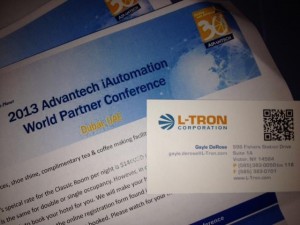
Searching Google for “Internet of Things” produces 2,090,000,000 results. The Internet is a very big place, but 2.09-billion results is a lot, even from a pool as large as the Internet. By comparison, “Justin Bieber” yields only 793-million results and “Cloud Computing” just 567-million.
Yet for many among us, IoT remains a frustratingly vague concept because the Internet searches that we conduct via Bing, Google, Yahoo! rarely reveals any of the 1.9-billion+ devices that currently make up the IoT. That Google list of 2.09-billion results for “Internet of Things” includes none of those actual “things.” Of course, there is a scary search engine that crawls the webcams and printers and routers, et al, that populate the IoT – the physical Internet – but more on that later.
The Internet of Things and Cloud Computing were frequent topics of Advantech’s 2013 conference in Dubai, and because we always enjoy learning details of actual IoT installations, we particularly enjoyed Gunnar Beauregard’s (General Manager of Kesseltronics Systems, a division of Dover Corporation of Montreal, Canada) example of a carwash. The carwash interacts via the Internet in three distinct ways:
- Device to Server: The carwash local systems post transactional information to the Cloud-based servers as each car is washed and also transmits condition messages to a service provider alerting it that the carwash is running low on a specific wax, or such.
- Server to Device: The server does such things as automatically pushing special pricing when regional wash sales are low or adjusting pricing to lead customers away from products that are temporarily unavailable.
- Cloud Computing: Application processes run on Cloud servers, not at the endpoint devices, simplifying equipment at the delivery end and facilitating coordination of multiple carwash facilities. Inputs are debouced at the carwash level, and high-speed processes are handled locally, as well, while human-interaction processes are performed at the Cloud-server level. Redundant distributed server architecture yields high availability and self-healing systems.
The advantages of this arrangement are many. Programming is more efficiently conducted at the server level than at disparate embedded local systems, allowing dramatic simplification of each carwash facility and, in turn, reducing the time and cost required for installation of new carwashes and maintenance of existing ones. Because programming is Cloud-based, software-upgrade procedures are also simplified.
The carwash example in question relies upon Advantech’s new ECU-1911 all-in-one remote terminal unit for control, communication
and computing functions at the local level. The ECU-1911 is supported by Advantech’s DAQNavi SDK integrated software to enable programmers to easily develop custom data-acquisition applications. The ECU-1911 is compact and can be mounted on a DIN rail or wall mounted.
As each input event occurs, the ECU-1911 sends a message to the Cloud servers that identifies it by serial number and that indicates its input state. The servers correlate the input to an event, such as payment or low-wax status. The servers save the event to an upstream database and the event history is available to managers via an Internet interface.
Sounds simple, no? Oh, and that search engine that sniffs out the “things” on the Internet that Google misses? It’s called Shodan (www.shodanhq.com), and although it has yet to reveal the entire IoT, it does collect information on approximately 500-million connected devices per month – something to consider when designing security for your connections to the Internet of Things.













